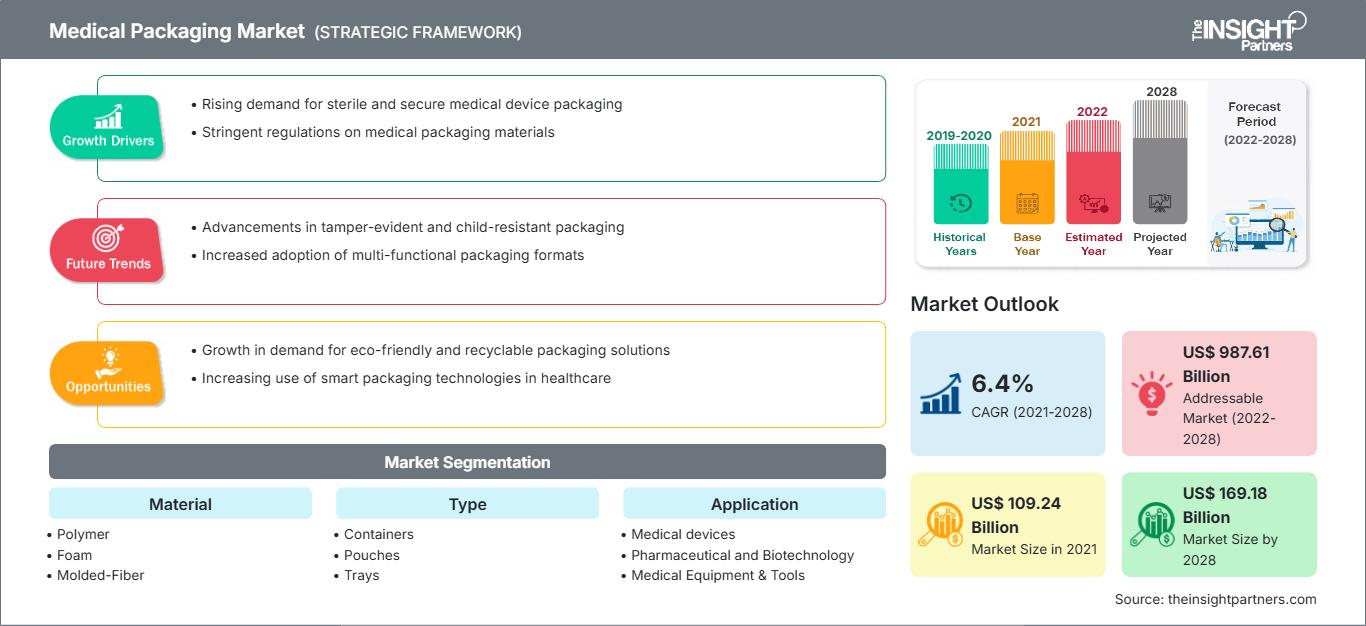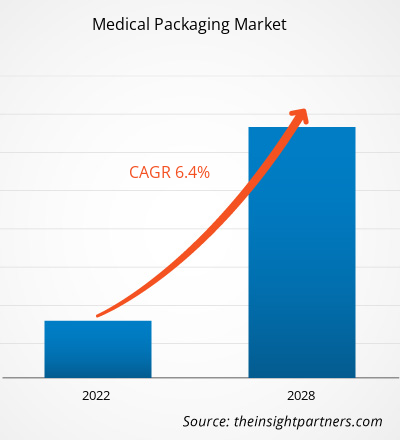Le marché de l'emballage médical devrait atteindre 169 183,91 millions de dollars américains d'ici 2028, contre 109 238,35 millions de dollars américains en 2021 ; sa croissance devrait atteindre un TCAC de 6,4 % entre 2021 et 2028.
L'emballage médical est essentiel pour maintenir la qualité des produits et encourager une utilisation sûre et efficace. Il est conçu pour assurer la sécurité des produits médicaux lors de leur stockage, de leur distribution, de leur vente et de leur utilisation. Le matériau utilisé pour l'emballage est un système de barrière stérile qui protège les médicaments, l'équipement et les autres produits médicaux. De plus, l'emballage médical exige une qualité de stérilité élevée pour garantir l'absence de contamination. Ces systèmes d'emballage médical augmentent la sécurité des patients et améliorent les performances de l'emballage. Des facteurs tels que l'importance accrue accordée à la commodité et aux questions environnementales, ainsi que la demande croissante de mécanismes de prévention de la contrefaçon, stimulent le marché de l'emballage médical. Toutefois, les fluctuations des prix des matières premières devraient limiter la croissance du marché dans une certaine mesure au cours de la période de prévision.
Vous bénéficierez d’une personnalisation sur n’importe quel rapport - gratuitement - y compris des parties de ce rapport, ou une analyse au niveau du pays, un pack de données Excel, ainsi que de profiter d’offres exceptionnelles et de réductions pour les start-ups et les universités
Marché de l'emballage médical: Perspectives stratégiques

- Obtenez les principales tendances clés du marché de ce rapport.Cet échantillon GRATUIT comprendra une analyse de données, allant des tendances du marché aux estimations et prévisions.
Aperçu du marché
Augmentation de la demande de mécanismes de prévention de la contrefaçon
Des produits médicaux contrefaits ont été détectés dans la plupart des États membres et dans toutes les régions. Il s'agit notamment de médicaments largement utilisés comme l'atorvastatine ou le paracétamol ; de médicaments à usage limité comme l'hormone de croissance, le paclitaxel et le filgastrim ; et d'autres types de médicaments comme le sildénafil et le tadalafil, ainsi que de dispositifs médicaux comme les lentilles de contact, les préservatifs, les filets chirurgicaux et les bandelettes utilisées par les patients diabétiques pour surveiller leur glycémie. La contrefaçon touche aussi bien les produits chers que bon marché, les génériques et les produits de marque. On trouve des produits contrefaits dans les pharmacies d'officine, les hôpitaux et d'autres établissements moins réglementés.
On suppose souvent que les pays à revenu élevé dotés de systèmes réglementaires solides peuvent efficacement exclure de leurs marchés les produits médicaux de qualité inférieure et falsifiés. Cependant, l'analyse de l'Organisation mondiale de la santé (OMS) montre que ce n'est pas nécessairement le cas, car des rapports sur ces produits ont été soumis par des pays d'Europe occidentale et d'Amérique du Nord, ainsi que par d'autres pays à revenu élevé. Par exemple, une récente enquête britannique, menée par Sapio Research et commandée par la société privée INCOPRO, conclut que près d'un tiers (32 %) des personnes ayant acheté un ou plusieurs médicaments contrefaits ont souffert d'un problème de santé à la suite de cet achat (INCOPRO, 2020). De nombreux autres cas documentés de patients sont décédés ou ont subi des préjudices suite à un achat en ligne. À titre d'exemple, en 2013, des personnes sont décédées après avoir pris une pilule amaigrissante contrefaite achetée auprès d'un vendeur de médicaments en ligne. Cette pilule, vendue comme aide à la perte de poids par de nombreuses pharmacies en ligne illicites, était en fait un pesticide aux conséquences mortelles pour l'homme.
La menace que représentent les médicaments contrefaits pour le secteur pharmaceutique mondial est immense. Des formulations contrefaites aux problèmes de fabrication, certains acteurs du secteur estiment que les pertes de revenus pourraient atteindre 27 milliards d'euros rien qu'en Europe. L'International Hologram Manufacturers Association (IHMA), experte dans ce domaine, met en avant un rapport sectoriel qui indique une croissance continue des technologies d'emballage anti-contrefaçon. Selon l'IHMA, le rapport « Technologies anti-contrefaçon, d'authentification et de vérification » souligne l'expertise supplémentaire apportée par l'holographie à l'authentification des produits d'emballage. L'innovation technologique dans les technologies d'anti-contrefaçon, d'authentification et de vérification est un facteur important contribuant à la croissance du marché.
La demande croissante de techniques anti-contrefaçon pour protéger les intérêts des patients a encore renforcé la croissance du marché des emballages médicaux.
Informations par type
Le marché des emballages médicaux est classé par type : conteneurs, sachets, plateaux, plaquettes thermoformées, flacons, etc. En 2021, le segment des contenants détenait la plus grande part de marché, par type. Le segment des plaquettes thermoformées devrait connaître une croissance significative au cours de la période de prévision, en raison de l'augmentation des développements et des lancements de produits.
Informations basées sur les matériaux
Le marché de l'emballage médical est segmenté en polymères, mousses, fibres moulées, non-tissés, films, papier et carton, entre autres, selon les matériaux. En 2021, le segment des polymères détenait la plus grande part de marché, par matériau. De plus, un segment similaire devrait connaître la croissance la plus rapide au cours des prochaines années.
Informations basées sur les applications
Le marché de l'emballage médical est segmenté en dispositifs médicaux, produits pharmaceutiques et biotechnologiques, équipements et outils médicaux, entre autres, selon les applications. En 2021, le segment pharmaceutique et biotechnologique détenait la plus grande part de marché. Le même segment devrait croître à un TCAC significatif au cours de la période de prévision en raison de la production croissante de produits pharmaceutiques et biotechnologiques sur les marchés mondiaux en raison de la prévalence croissante des maladies chroniques.
Diverses entreprises opérant sur le marché de l'emballage médical adoptent des stratégies telles que les lancements de produits, les fusions et acquisitions, les collaborations, les innovations de produits et les extensions de portefeuille de produits pour étendre leur empreinte mondiale, maintenir la marque et répondre à la demande croissante des utilisateurs finaux.
Emballage médical.Aperçu régional du marché de l'emballage médical
Les tendances régionales et les facteurs influençant le marché de l'emballage médical tout au long de la période de prévision ont été analysés en détail par les analystes de The Insight Partners. Cette section aborde également les segments et la géographie du marché de l'emballage médical en Amérique du Nord, en Europe, en Asie-Pacifique, au Moyen-Orient et en Afrique, ainsi qu'en Amérique du Sud et en Amérique centrale.
Portée du rapport sur le marché de l'emballage médical
| Attribut de rapport | Détails |
|---|---|
| Taille du marché en 2021 | US$ 109.24 Billion |
| Taille du marché par 2028 | US$ 169.18 Billion |
| TCAC mondial (2021 - 2028) | 6.4% |
| Données historiques | 2019-2020 |
| Période de prévision | 2022-2028 |
| Segments couverts |
By Matériaux
|
| Régions et pays couverts | Amérique du Nord
|
| Leaders du marché et profils d'entreprises clés |
|
Densité des acteurs du marché de l'emballage médical : comprendre son impact sur la dynamique commerciale
Le marché de l'emballage médical connaît une croissance rapide, portée par une demande croissante des utilisateurs finaux, due à des facteurs tels que l'évolution des préférences des consommateurs, les avancées technologiques et une meilleure connaissance des avantages du produit. Face à cette demande croissante, les entreprises élargissent leur offre, innovent pour répondre aux besoins des consommateurs et capitalisent sur les nouvelles tendances, ce qui alimente la croissance du marché.

- Obtenez le Marché de l'emballage médical Aperçu des principaux acteurs clés
- Analyse historique (2 ans), année de base, prévision (7 ans) avec TCAC
- Analyse PEST et SWOT
- Taille du marché Valeur / Volume - Mondial, Régional, Pays
- Industrie et paysage concurrentiel
- Ensemble de données Excel
Rapports récents
Rapports connexes
Témoignages
Raison d'acheter
- Prise de décision éclairée
- Compréhension de la dynamique du marché
- Analyse concurrentielle
- Connaissances clients
- Prévisions de marché
- Atténuation des risques
- Planification stratégique
- Justification des investissements
- Identification des marchés émergents
- Amélioration des stratégies marketing
- Amélioration de l'efficacité opérationnelle
- Alignement sur les tendances réglementaires




















 Obtenez un échantillon gratuit pour - Marché de l'emballage médical
Obtenez un échantillon gratuit pour - Marché de l'emballage médical